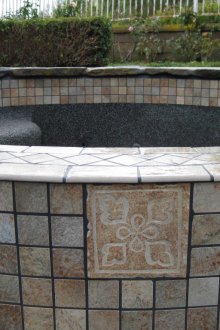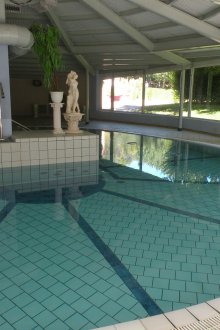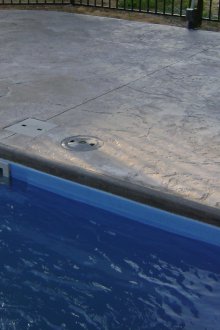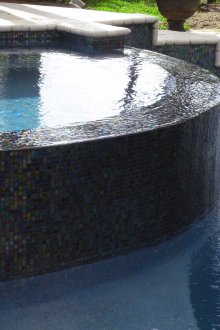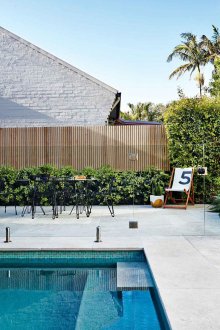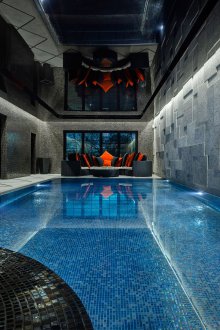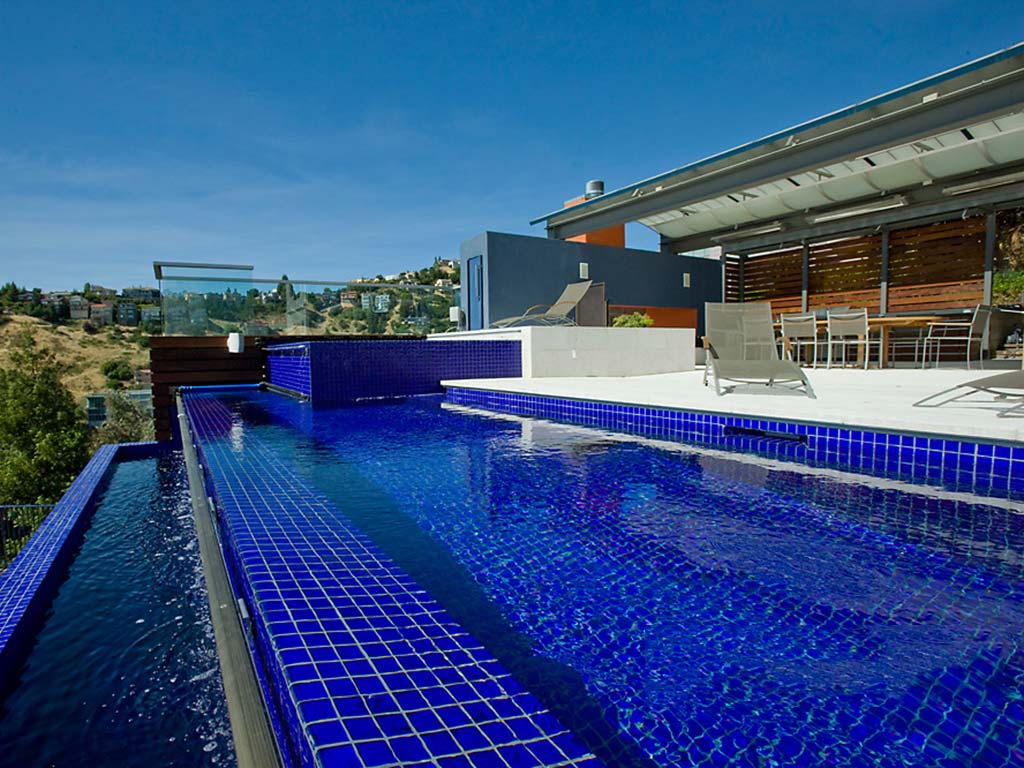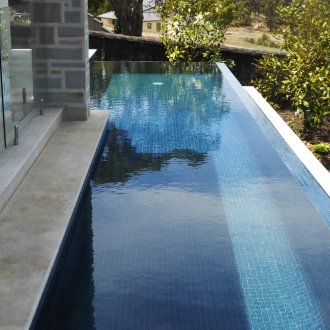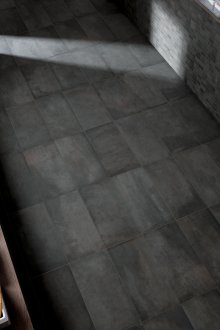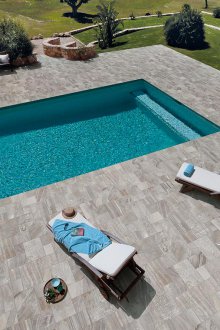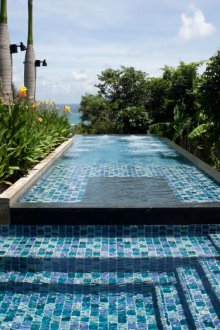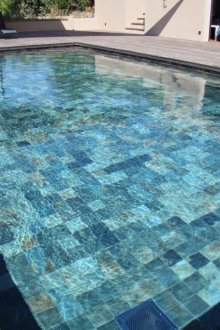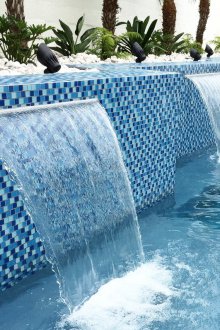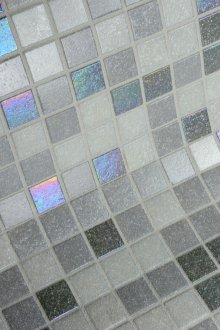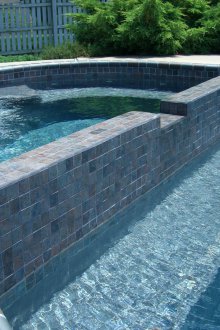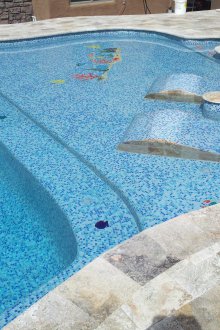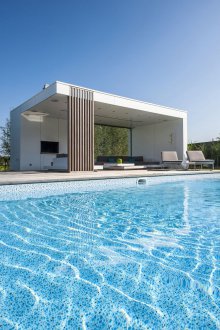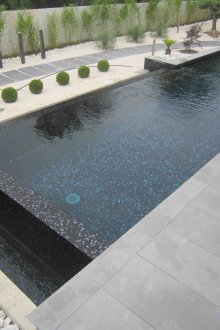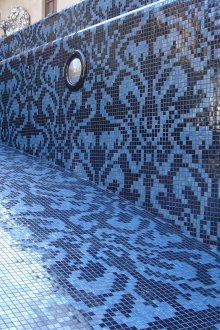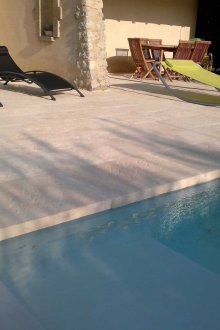Tile for the pool: create the seabed (21 photos)
The pool can be located on the street or indoors and operated in different conditions. The ideal option for decorating the bowl is tiling the surface. Finishing mixtures and glue should not affect the quality of water or be a medium for the propagation of microorganisms, so the appropriate compositions are selected. Tiled material must also have special qualities and satisfy certain criteria.
Outdoor pool tiles must meet the following requirements:
- to be moisture resistant. Low water absorption will help the tile to survive and not collapse under the influence of water. These qualities are possessed by tiles with a glazed surface and a finely porous structure;
- strength, reliability tiles. The coating acquires these characteristics when the material is fired at high temperatures. Features of the process - when baking, the particles seem to “stick together” and a tile with a very dense structure is created. In this process, pores / voids should not form in the tile body, since they adversely affect the density of the material. The coating must withstand high water pressures;
- rounded corners ensure the safety of swimmers. Otherwise, with the smallest flaw in the styling (protruding edge), there is a chance of injury to parts of the body or skin cut;
- anti-slip tiles for the pool can guarantee safety in the bowl. Certain types of tiles provide anti-skid due to various features: the surface of the clinker tile has a rough texture, corrugated tile has a non-uniform texture. Due to the small size of the mosaic tiles and a large number of tile joints, a non-slip effect is also manifested;
- frost resistance is characteristic of tiles, which are used for facing outdoor pools. The material must withstand several cycles of severe temperature change. As an example: porcelain tiles can survive 25 freezing cycles, and clinker tiles for the pool about 300.
Classification of decor for pools is made precisely by the anti-skid parameters: products are tested for surface inclination. If the bare foot does not slip at 12˚, then the material is classified as class A (suitable for arranging footpaths), respectively 18˚ - class B (for the area in the showers, near the sides) and 24˚ - class C (areas near the pool and steps )
Large tiles are not used for flooring, which is caused by the action of more pressure exerted by water. The optimal size is 125x245 mm or 150x150 mm.
Mosaic
Glass tile for the pool is of high quality. Mosaic is stronger than ordinary glass and has the following advantages:
- ideal for cladding uneven / curved surfaces and creating panels or different color combinations (the most common are blue and green);
- hygienic and resistant to chemicals and acids;
- has maximum water resistance (the ability of the material not to absorb and not to pass water until the hydrostatic pressure reaches a certain value);
- high frost resistance - withstands about 100 cycles;
- excellent color fastness - the material retains the brightness of shades under prolonged exposure to solar radiation.
Disadvantages: high cost and slippery surface (therefore, it is recommended to use material for decorating the walls of the pool).
Mosaic tiles for the pool bowl are fixed on a special grid and are available in special tiles - chips, the size of which varies.
For pools use mix chips (with shades of the same color) or a stretch of tiles of different colors. Original and non-standard look tiles under a tree or color panels. To create paintings, a mosaic can be cut into centimeter or two centimeter squares. In this case, the picture is collected manually.
Material is laid on carefully leveled surfaces. It is preliminary recommended to process coatings with waterproofing compounds. For gluing mosaics, a white adhesive is used (other shades may change the color of the coating).
Ceramic tile for pools
Continuous improvement of the quality of tiles allowed to improve the characteristics of the material. Thanks to special technologies, the tiles for the pool acquired a higher density of the structure, and its porosity decreased.
Material Advantages:
- strength and durability;
- aesthetic appearance;
- high water repellent qualities;
- hygiene and safety;
- easy care.
Facing the pool with tiles is carried out only by china and some clinker views. Only these types of ceramics have a sufficiently low rate of moisture absorption.
Porcelain tiles (a mixture of white clay, kaolin, quartz and feldspar) are pressed in a special way that reduces the porosity of the structure. Then the material is fired at 1273-1310 ° C. As a result, all components are melted and compacted, giving the mixture high density and special mechanical strength. The material is characterized by the lowest water absorption rate - 0.01%.
For the production of clinker tiles, shale refractory clay is used. After firing at high temperatures - from 1230 to 1470 ° C, the floor tiles for the pool acquire the strength of the stone and it is almost impossible to scratch.
Advantages are also: a long service life, high frost resistance (about 300 cycles), minimal moisture absorption (about 3-4%) - it practically does not absorb water, and its impressive texture (which can last for decades). For laying on the pool floor, a square tile with sides of 150 mm is used. The traditional shades of clinker are a red palette (from brown to orange).
Laying tiles in the pool
Most often, decoration is sold in collections consisting of specially selected elements (panels, friezes, background tiles).
The key to high-quality lining of the bowl are the correctly carried out preparatory stages. As a rule, the bowl is made of concrete and has a monolithic appearance. The surface is rarely even, the main defects: uneven form, uneven application of a primer, dirty surface. To eliminate these shortcomings, the surface is washed, leveled and ground.
- The bowl is waterproofed with special compounds designed for long periods under water.
- The surface must be treated with a polymer primer. You can start facing work in five days.
- The choice of adhesive mixture must be given maximum attention. Only a few compounds are able to withstand the constant effects of water, therefore, to increase the adhesion of the tile to the concrete wall, it is recommended to add latex to the glue. For the correct application of the adhesive composition, a notched trowel is used (selected according to the size of the tile). To maintain the distance between the individual parts, plastic crosses are used.
- Tile is being laid. If there are doubts about the quality of the material, it is better to clarify this issue in advance - read the manufacturer's recommendations.
- Of particular importance is the processing of interseam joints.The seams between the tiles in the pool are left wider than during normal operations. The surface of each tile slightly bends under high pressure, which leads to the expansion of the tile. With narrow seams, the tile will begin to slowly crack and collapse.
- When choosing sealants for grouting, it should be borne in mind that not every composition tolerates the long-term exposure to the chemical environment (chlorine and other liquids are added to the water), so grout for tiles in the pool should well tolerate not only the effects of water, but also aggressive chemical environment . The hue of the grout is matched to the tone of the main tile or contrasting color.
- The drying time of the decorative coating is determined by the condition for repair work, the characteristics of the primer, adhesive, sealant. At an air temperature of + 21 ° C, a period of 15 to 22 days is required for the pool to completely dry.
Stationary outdoor pools made of concrete are the most durable and durable. Bowls with quality work performed look better and last longer than those in which hastily finished. All stages of the repair should be carried out slowly and accurately, in compliance with technological terms.
